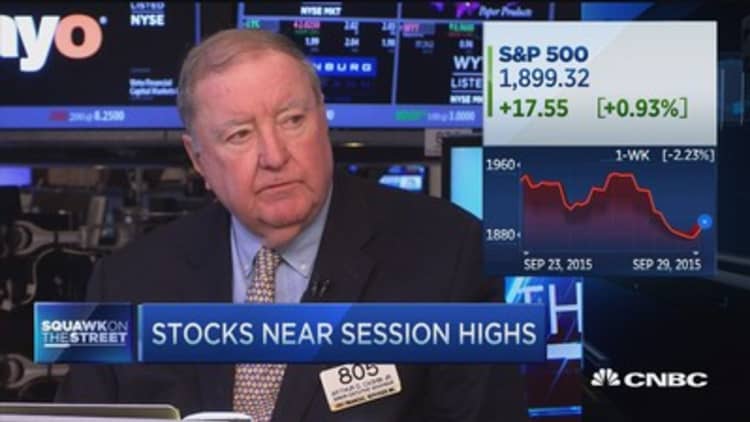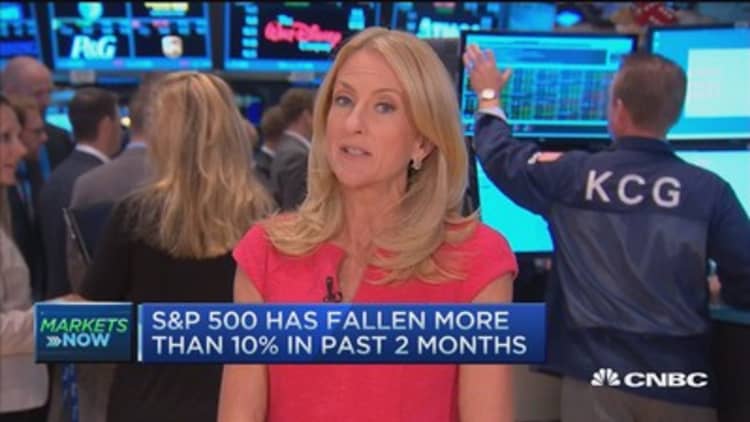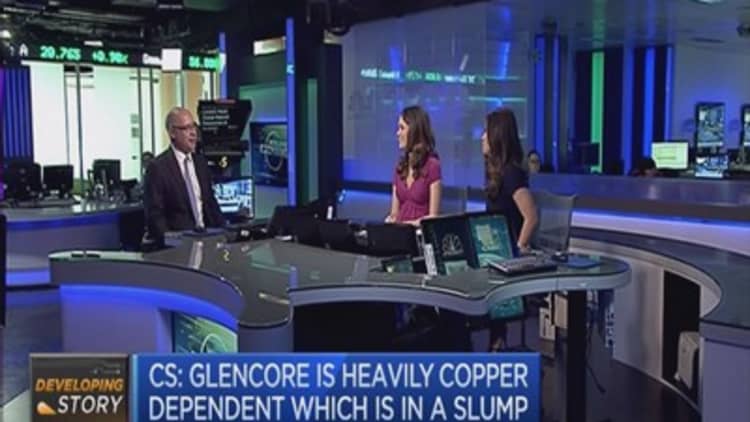


U.S. stocks closed mixed Tuesday, attempting to stabilize after a sharp sell-off, as commodities recovered slightly but biotech stocks failed to hold gains. (Tweet This)
The Dow Jones industrial average and S&P 500 ended higher, while the Nasdaq closed lower. The Dow managed to end above the psychologically key 16,000 level, while the S&P 500 remained below 1,900 after closing below that level Monday.
The major averages fluctuated between gains and losses throughout the day.
"People are waiting, or wanting, to see if we can retest the August lows before they step back in," said Peter Coleman, head of trading at Convergex. "There's no catalyst to get this market going forward. We're into a downtrend until we get some clear feedback— where the Fed's going? Can oil bottom? (Until) the 10-year can get to 2.30, 2.50, it indicates a ton of fear in the market."
Read More5 things that keep Carl Icahn up at night
The iShares Nasdaq Biotechnology ETF (IBB) gave back about 4 percent in intraday gains to close 0.4 percent lower, extending Monday's 6.3 percent plunge.
The Nasdaq composite closed down about 0.6 percent, weighed by declines in IBB and a 3 percent loss in Apple. In choppy intraday trade, the index both gained and lost more than 1 percent.
The Dow closed 47 points higher, recovering from a mild decline after earlier gaining as much as 117 points. 3M and Johnson & Johnson contributed the most to gains in the blue chip index, while Apple was the greatest weight.
"Obviously it's a market trying to gain some semblance of a bounce. This remains a very frustrated market," said Quincy Krosby, market strategist at Prudential Financial.
"There doesn't seem to be much conviction. The good thing is you don't see much conviction on the downside either," she said. "To have a kind of quiet market is more comforting for the average investor."
Crude oil futures settled up 80 cents, or 1.80 percent, at $45.23 a barrel on the New York Mercantile Exchange. Gold futures ended down $4.90 at $1,126.90 an ounce. Copper held higher.
"We've got a little bit of a bounce in oil ... and a little bit of a lift from Glencore and miners," said Art Hogan, chief market strategist at Wunderlich Securities.
"Coming into today the big test is, is this a double-bottom test of the lows of (August) 25?" he said.
Read MoreStocks may be setting up for negative year
The major averages remained in correction territory, or more than 10 percent below their 52-week highs, after closing there Monday. The Dow was about 4.4 percent above its Aug. 24 low, while the Russell 2000 remained below its Aug. 24 low.
The Nasdaq also flashed a death cross Monday, with its 50-day moving average falling below the 200-day.
"We expect the relief rally to fade this afternoon given the intraday breakdown and new overhead resistance. One more downdraft appears likely from a momentum standpoint, so we expect the SPX to briefly dip below its August low following the lead of the Russell 2000 Index," BTIG Chief Technical Strategist Katie Stockton said in a morning note.
Major averages 12-month performance
Earlier, gains in commodity prices and Europe helped U.S. stock futures reverse early losses, with Dow Jones industrial average futures earlier up about 40 points.
"Despite what the futures say there's going to be some pressure early on from margin calls, liquidation pressure," said James Meyer, chief investment officer at Tower Bridge Advisors.
"There are things out there that can give investors a little bit of hope," he said, noting that oil prices remain near $45 a barrel despite stocks moving closer to their late August lows.
Glencore closed up nearly 17 percent in London trade, after plunging nearly 30 percent Monday to extend recent losses amid concerns about debt levels for the commodities and trading giant. On Tuesday, a number of brokers said worries about the firm's debt pile were overdone.
Read MoreIs Glencore the mining sector's Lehman?
The bounce helped European stocks recover from a sharply lower open to close mildly lower. Asian stock markets ended the day with major losses, with Chinese stocks off more than 2 percent and Japan's blue-chip Nikkei stock index closing down 4.05 percent.
Signs of weakness in China — the world's second biggest economy — has battered commodity prices such as copper and iron ore this year, and in turn companies in the metals and mining sectors.
Goldman Sachs cut its year-end forecast for the S&P 500 by 5 percent to 2,000 on Tuesday, citing a combination of the slower pace of economic activity in China and the U.S. and the fall in oil prices.
Major U.S. Indexes
On Monday, the S&P 500 stock index fell to a one-month low, closing below 1900, as a plunge in biotechs weighed heavily on health care. A rise in consumer spending data for August added to an improving U.S. economic picture that could support a near-term rise in rates.
"Yesterday was probably an overreaction and we'll probably get a bounce back (Tuesday)," Meyer said. "If the news in China doesn't decelerate at an enormous pace and oil hangs in around $45, it's going to be hard to make the case for a huge drop from here. There are too many parts of the economy that are doing well."
Read MoreStocks head to lows, may set up for negative year
On Tuesday, S&P/Case-Shiller's 20-City Index reported a 5 percent rise in July, roughly in-line with analysts' estimates for a 5.1 percent increase.
The September consumer confidence index came in at 103.0, topping August's read of 101.3.
"Bottom line, in contrast to the University of Michigan confidence measure, this survey has shown the consumer little bothered by the stock market selloff and more focused on the improvement in income growth," Peter Boockvar, chief market analyst at The Lindsey Group, said in a note.
"While I only take consumer confidence data with a grain of salt because they can be fickle, are typically not leading indicators and are rarely market moving, the income component is another anecdotal sign of improving wage gains which is encouraging to see," he said. "'International developments' didn't sway confidence either."
Treasury yields held lower, with the 10-year at 2.05 percent and the at 0.65 percent.
The U.S. dollar traded mildly lower against major world currencies, with the euro near $1.12 and the yen at 119.77 yen against the greenback.
"With the end of the quarter here, most likely the institutions have already closed their positions, which means we could see less pressure," said Peter Cardillo, chief market economist at Rockwell Global Capital.
"But if we don't hold yesterday's close that makes me extremely worried that this market is going to enter bear market territory," he said.
Investors also kept an eye on the federal government in Washington, which faces a deadline on budget negotiations. If a deal is not reached, the government could shutdown as of Thursday.
Read MoreEarly movers: YHOO, MCD, AAPL, MSFT, PNRA, POM, LLY, JNJ & more
The Dow Jones Industrial Average closed up 47.24 points, or 0.30 percent, at 16,049.13, with 3M leading advancers and Apple the greatest decliner.
The Dow transports closed mildly higher, with Matson leading advancers.
The closed up 2.32 points, or 0.12 percent, at 1,884.09, with health care leading six sectors higher and information technology leading decliners.
The Nasdaq closed down 26.65 points, or 0.59 percent, at 4,517.32.
The CBOE Volatility Index (VIX), widely considered the best gauge of fear in the market, traded near 26.5.
About eight stocks declined for every seven advancers on the New York Stock Exchange, with an exchange volume of 1.0 billion and a composite volume of 4.1 billion in the close.
On tap this week:
Tuesday
Midnight deadline for Congress to approve budget
Wednesday
8 a.m.: New York Fed's Dudley on market liquidity
8:15 a.m.: ADP employment
9:45 a.m.: Chicago PMI
3 p.m.: Fed Chair Janet Yellen welcoming remarks at St. Louis Fed event
3:10 p.m.: St. Louis Fed President James Bullard at St. Louis Fed community banking event
8:15 p.m.: Fed Gov. Lael Brainard at St. Louis Fed event
Thursday
September vehicle sales
8:30 a.m.: Initial claims
9:45 a.m.: Manufacturing PMI
10 a.m.: ISM manufacturing; construction spending
2:30 p.m.: St. Francisco Fed's Williams on outlook
Friday
8:30 a.m.: Employment; Boston Fed President Eric Rosengren at Boston Fed conference
9 a.m.: Minneapolis Fed President Narayan Kocherlakota
10 a.m.: Factory orders
11 a.m.: Cleveland Fed President Loretta Mester
1:30 p.m.: Fed Vice Chair Stanley Fischer on monetary policy at Boston Fed
More from CNBC.com:







